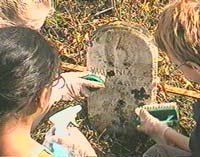
·Run hand up back of stone. If particles
come off, stone is a problem for cleaning.
·Must use non-ionic cleaners: best is water only or Photo-Flo
(a photographic detergent/drying agent by Kodak, available at
photo supply stores).
·For markers with thick algae/lichen growth, use D/2 Industrial
Grade Architectural Biocide, distributed by Cathedral Stone Products,
Inc.
·For granite markers, you can use ammonia but wash off
thoroughly.
·Do not use metal bruses of any kind; can use plastic "Tuffies".
·Clean markers by starting at bottom so as to avoid streaking
from top down.
A Few Words of Caution
Work in a graveyard cannot be taken lightly. Although activities such as debris removal and research of the yard and people can only be positive, restoration of the markers can be tricky and technical. Only certain types of chemicals should be used to clean certain stone types, household cleaners not being among them. Many are acidic and will greatly degrade limestone and marble. One exception might be household ammonia on granite. However, it is somewhat noxious and you might not want to use it with students.
For broken stones, the choice of adhesives is even smaller and
can be purchased and used only after training. Cement or epoxy
should not be used to glue stone fragments together. Gravestones
act like wicks and moisture must be able to move up and down the
stone. Epoxies and other sealants form a barrier to the moisture
movement and the stones will deteriorate more rapidly.

|
|
|
|
|
| Photographic Record |
|
|
|